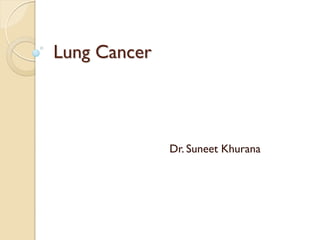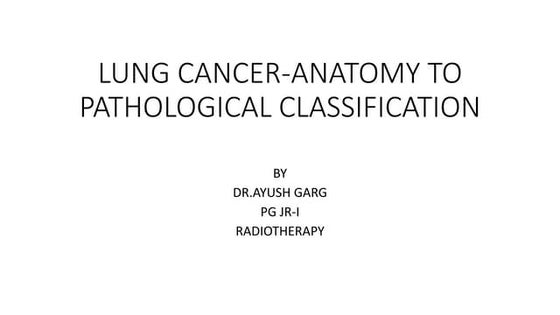Lung Cancer
- 1. Lung Cancer Dr. Suneet Khurana
- 2. Lung Cancer
- 3. Etiology of Lung Cancer ’éŚ Tobacco Smoking x 13.3 times (10 ŌĆō 20) (78-90%) ’éŚ 2nd hand smoke (15%) ’éŚ Asbestos x 5 ŌĆō 90 times ’éŚ Radon (2-3%) ’éŚ Arsenic ’éŚ Ionizing radiation ’éŚ Beryllium, Nickel, Copper ’éŚ Chromium, Cadmium ’éŚ Diesel Exhaust ’éŚ Polycyclic aromatic hydrocarbons
- 4. Epidemiology of Lung Cancer
- 5. Epidemiology
- 6. Epidemiology
- 7. Symptoms - Signs of Lung Cancer Symptom / Signs Cough 74% Dyspnea 37% Hemoptysis 57% Recurrent Pneumonia Chest Pain, Wheezing 25% Dysphagia Laryngeal Nerve Paralysis 18% Horners Syndrome Pancoast Syndrome Superior Vena Cava Syndrome Atelectasis Pleural Effusion
- 8. Pathological Classification Non Small Cell Lung Cancer Small Cell Lung Cancer (NSCLC) (SCLC) Squamous Cell Carcinoma 25 ŌĆō 30% Oat Cell Carcinoma Adenocarcinoma 35-40% Intermediate Cell Carcinoma Large Cell Carcinoma 10-15% Combined Cell Carcinoma
- 9. TNM Staging (AJC CS ERR) Primary Tumor - T T1 Tumor <3cm without invasion more proximal than lobar bronchus T2 Tumor >3cm OR of any size with any of the following - Invades Visceral Pelura - Atelectasis of less than entire lung - Proximal extent of at least 2cm from carina T3 Tumor of any size with any of the following - Invasion of Chest Wall - Invasion of Diaphragm, Mediastinal Pleura, Pericardium - Atelectasis involving entire lung - Proximal extent within 2cm of carina T4 Tumor of any size with any of the following - Invasion of mediastinum - Invasion of heart or great vessels - Invasion of vertebral body - Presence of malignant pleural or pericardial effusion - Satellite tumor nodes within same lobe as primary tumor
- 10. TNM Staging Nodal Involvement - N N0 No regional node involvement N1 Involvement of ipsilateral hilar or ipsilateral peribronchial nodes N2 Involvement of ipsilateral mediastinal or subcarinal nodes N3 Involvement of contralateral mediastinal or hilar nodes OR Ipsilateral or contralteral scalene or supraclavicular nodes Metastasis - M M0 Distant Metastasis absent M1 Distant Metastasis present
- 11. Stage I Stage IA T1 N0 M0 Stage IB T2 N0 M0
- 12. Stage II Stage IIA T1 N1 M0 Stage IIB T2 N1 M0, T3 N0 M0
- 13. Stage IIIa Stage IIIA T3 N1 M0, T1-3 N2 M0
- 14. Stage IIIb Stage IIIB Any T N3 M0, T4 Any N M0
- 15. Stage IV Stage IV Any T Any N M1
- 16. Investigations for Lung Cancer
- 17. Investigations Diagnostic Tests Staging Tests Chest X-Ray CT Scan - Chest, Brain, Abdomen Bronchoscopy PET Scan Ultrasound Guided Biopsy Bone Scintigraphy CT guided Biopsy Mediastinoscopy Bone Marrow Biopsy
- 18. Chest X-Ray ŌĆō Diagnostic
- 19. Fiberoptic Bronchoscopy - Diagnostic Bronchoscopy Video
- 20. Ultrasound Guided Biopsy - Diagnostic
- 21. CT Guided Biopsy - Diagnostic
- 22. CT Scan - STAGING
- 23. PET Scan for STAGING
- 24. Fused PET and CT Scan
- 26. Bone Scintigraphy for STAGING
- 27. Bone Marrow Aspiration - STAGING
- 28. Current Treatments for NSCLC
- 29. Treatment Options SURGERY TARGETED RADIOTHERAPY THERAPY CHEMOTHERAPY
- 30. Treatment by Stages of Cancer Stage Description Treatment Options Stage Ia ŌĆō Ib Tumor localized in lung Surgical resection Stage IIa ŌĆō IIb Tumor spread to local lymph nodes Surgical resection Stage IIIa Tumor spread to regional lymph Chemotherapy followed nodes in trachea, chest above by radiation or surgery diaphragm Stage IIIb Tumor spread to contra lateral Combination of lymph nodes Chemotherapy and Radiation Stage IV Tumor metastasis to organs outside Chemotherapy and or chest palliative care
- 31. Surgery ŌĆō Wedge, Lobectomy, Pneumonectomy
- 32. Radiation Therapy ’éŚ Treatment of stage I and stage II NSCLC, radiation therapy alone is considered when surgical resection is not possible. ’éŚ Role of radiation therapy as surgical adjuvant therapy after resection of the primary tumor is controversial. ’éŚ Radiation therapy reduces local failures in completely resected (stages II and IIIA) NSCLC but has not been shown to improve overall survival rates. ’éŚ Radiation therapy alone used as local therapy has been associated with 5-year survival rates of 12-16% in early-stage NSCLC (ie, T1 and T2 disease). ’éŚ No randomized trials have directly compared radiation therapy alone with surgery in the management of early- stage NSCLC
- 33. Chemotherapy ’éŚ Only 30% of patients with NSCLC become eligible for surgical resection ’éŚ 50% of patients who undergo resection experience either a local or systemic relapse of cancer ’éŚ 80% of patients with NSCLC end up taking some sort of chemotherapy ’éŚ Combination chemotherapy has better survival rates than single agent chemotherapy, which has potentially no role in curative therapy of NSCLC. ’éŚ Adjuvant chemotherapy (after surgery) has failed to elicit any benefits, however neoadjuvant chemotherapy (given prior to surgery) has improved survival in patients with Stage IIIa disease.
- 34. Chemotherapeutic Agents Drug Mechanism of Action Toxicity Cisplatin / Carboplatin Causes intrastrand and interstrand cross- Tinnitus, Hearing Loss, linking of DNA, - strand breakage Toxic Neuropathy, Myelotoxic Vinorelbine It inhibits tubulin polymerization during G2 Granulocytopenia, phase of cell division Constipation, Fatigue Gemcitabine Antimetabolite that acts as inhibitor of DNA Myelosuppression, Flu synthesis like symptoms, Hemolytic Uremic Syndrome, Lung toxicity Paclitaxel Inhibits tubulin depolymerization in spindle Myelosuppression, during cell division neuropathy, hypersensitivity Pemetrexed disodium Disrupts folate-dependent metabolic Fatigue, processes essential for cell replication. myelosuppression, Infection, GI toxicity Docetaxel Inhibits cancer cell growth by promoting Myelosuppression, fluid assembly and blocking disassembly of retention, HSN rxns microtubules Etoposide Causes single strand breaks in DNA, inhibits Myelosuppression, repair of DNA Transient Hypotension
- 35. Targeted Therapy
- 36. What are ŌĆ£targeted therapiesŌĆØ? ’éŚ Cytotoxic vs. Cytostatic ’éŚ Primarily target malignant cells ’éŚ Target molecules involved in: ŌŚ” cell growth signal transduction ŌŚ” angiogenesis ŌŚ” metastasis ’éŚ Generally less toxic at therapeutic doses ’éŚ Many are oral agents
- 37. Targeted Therapies Targets the HER2 receptor that is over-expressed in 25% of breast cancers
- 38. Targeted Therapies Targets the VEGF and inhibits angiogenesis in NSCLC and colorectal cancer
- 39. Epidermal Growth Factor Receptor EGFR EGFR is over-expressed in: ŌĆó many tumour types including NSCLC























































































